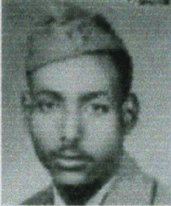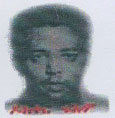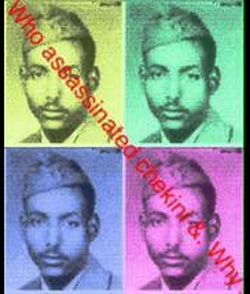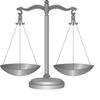
Researched and compiled by Resoum Kidane; with contribution by Mamanesrit Idris.
1940-1972
Researched and compiled by Resoum Kidane; with contribution by Mamanesrit Idris.
12-02-2018
Mahmoud Ibrahim Muhammad Saeed (Chekini was born in Keren in 1940 from the Habab tribe of Betasghade family and his great grandfather is kentebay Gergis. Chekini completed his elementary and junior education in Keren, thereafter he moved to Asmara to purse his secondary education at Jalia Arabic secondary school. During his student time he was a good footballer in Keren as well as in Asmara.
In the 1950s the youth’s resistance against the violations of the Federal Constitution intensified when Amharic became the official language in violation of the Eritrea Constitution which had declared Tigrinya and Arabic as the medium for primary education up to grade four, along with English.
During those years secondary school students were also influenced by Ato Woldeab Woldemariam radio programme which was broadcasts from Cairo. The radio programme played a great role in the revival of Eritrean nationalism in the 1950s.
Consequently sporadic student strikes became common, especially in Asmara in the 1950s. In 1957 the generation of Chekini actively participated in organizing demonstrations, in protesting the imposition of Amharic in Eritrean schools as the language of instruction, replacing Tigrigna and Arabic.
After 1957, Amharic became the most hated subject in schools in Eritrea. Ande Michael Kahassa in his interview recalls when we went to high school in 1959; there was resistance to Amharic in our group. ‘Our favourite method was to eat dried chickpea during class. It was very noisy. We were known as the chickpea market.’
When Chekini studied at Jalia Arabic secondary school, he was recruited by Haraket (MaHber ShewAte) probably between 1959 and 1960. In the late 1950s it was a common phenomena that when students moved to Asmara to pursue their secondary education to be recruited by Haraket (Mahber Shewate) same as Chekini . One of those students was Naizghi Kiflu who came to Asmara from Medefera to purse his secondary education, and became a member of the secret organization known as MaHber ShewAte.
After Arabic had been banned in the schools and replaced by Amharic more students had also left Eritrea for the Arab world to study (Connell,483). This could be a reason for Chekini’s father who tried to send his son to Cairo for higher education to study at University. However, on his way to Cairo, Chekini was captured by the Sudanese security service and was put in jail. This could be in the early 1960s. On is release he joined the ELF from Sudan in 1964
It is worth mentioning that in the early 1963 Syria was one of the first foreign supporters of the ELF. According Michael (2014) twenty ELF fighters got military training in Syria as early as 1963 and completed their training in 1964. Dan Connell (2010) also states that in 1960s approximately 300 Eritreans received military training in Syria .
Chekini was one of those fighters who went to Syria for military training at the Military Academy in the Syrian Arab Republic. Based on information obtained from Chekini’s daughter, he was sent for military training to Syria in 1964, after the first batch returned in 1964.
Chekini probably returned from Syria in 1965 when the Supreme Council of the ELF leadership deliberately divided the Eritrean Liberation Army by region and ethnicity through establishing four military zones based on a territorial division in order to control the movement of the fighters and to divide them, weakening the unit which they had built up during Haraket This new military structure instead of minimizing internal disputes, exacerbated the ethnic, religious and personal conflicts, resulting in intensive rivalry between different zones which was cause of inefficiency and disunity among the Zone Commands.
This period of division in the history of the Eritrean armed struggle (1965-1968) is called Zemene Kiflitat. Based on territorial division, Chekini who was from Senhit became the political commissioner of Zone Two which represented Sahel and Senhit, the commander of this zone was Omer Hamed Ezaz from Bilen Bet Tawqe family in Hal-Hal.
After serving for two years as the political commissioner of Zone two, Chekin and four other political commissioners from Zone one, three, four, and five went for further military training to China in 1967. (Larkin, Bruce D, (1971) provides a brief explanation of how the Chinese Communist Party offered this military training for the ELF fighters. According to Larkin, in 1966 at the Afro-Asian Writers’ emergence meeting which was held between 27 June and 9 July, it was resolved to give full support to the “Just war of liberation of the Eritrean people for national independence and sovereignty.
A year after this meeting as mentioned earlier, the ELF sent five fighters to China to study political ideology and guerrilla warfare at the Nanjing Military College in China, 1967. In this picture Mahmoud Ibrahim Chekini standing left to right between Isaias Afwerki and Ramadan Mohammed Nur, other ELF fighters Ahmed Adem Omer. Sitting L-R: 3rd Ahmed Ibrahim Ahmed.

According to his daughter, Chekini also founded the first a music band on the frontline in 1969, which could have been when he returned from China. During that year he was also elected to be a member of the General Command (Kiyada-al-Ama) at the Adobha Conference in 1969. At the Adobha conference all five Zones joined into one united army and a new leadership called the General Command (Kiada al-Ama). This leadership was formed to replace the Cairo-based Supreme Council and the Revolutionary Command liaison in Kassala.
In reaction to the General Command (Kiyada-al-Ama) decision to replace the Cairo-based Supreme Council, Osama Salhi Sabbe who was member of the Supreme Council and supporter of Zone Four or the Eastern lowland region spilt from the ELF.
According to (Iyob) Sabbe announced the formation of a new body the General Secretariat (GS) to replace the discredited Supreme Council. The General Command (Kiyada-al-Ama) refused to acknowledge the General Secretariat (GS) and responded by arresting fighters suspected of being adherents of Sabbe and launching a repressive campaign over the eastern lowland (ZONE FOUR) which were viewed as a Sabbe stronghold.
Further after the Adobaha conference the relation between Sabba and Idris M.Adem became more strained due to conflicts which were generated between 1965 and1969 (zemene-kiflitat). As a result of the rift between Sabba and Idris M.Adem all fighters member of Zone 4 (Semhar and Dankalia) who supported by Sabbe flee from the ELF persecution in the late 1960s [for further information read Osman Saleh Sabbe in his interview]
After Sabbe split the ELF-General Command held its first National Congress in Arr, Barka between 14 October and 12 November 1971 and elect Idres Mohammed Adem chairman who was the main rival of Sabbe.
Members of the 1st Revolutionary Council Democratically Elected at the 1971 Congress:
1. Idris Mohammed Adem, president
2. Herui Tedla Bairu, first vice president
3. Abdalla Idris Mohammed, second vice president
4. Saleh Ahmed Eyay, head foreign office
5. Mohammed Ismail Abdu, head of coordination
6. Ibrahim Mohammed Ali
7. Mohammed Osman Izaz
8. Ahmed Ibrahim Nafi’e (Halib Sete)
9. Mohammed Berhan Abdurahman
10. Ahmed Mohammed Nasser
11. Tesfai Tekle
12. Mohammed Saleh Humed
13. Shihem Ibrahim Shihem (later deserted to the enemy).
Chekin was also elected to members of the other 19 person Executive Committee by 1st ELF Congress in 1971.
Members of the ‘other’ 19-person Executive Committee Elected by 1st ELF Congress:
1.Idris Toteel, secretary of the ‘other’ Ex. Committee
2.Abdulkadir Ramadan
3.Mahmoud Ibrahim Chekini
4.Mahmoud Hasab
5.Ibrahim Abdalla
6.Saed Saleh
7.Idris Ali
8.Adem Moh. Hamid (Gindifil)
9.Omar Haj Idris
Suleiman Mussa Haj Humed Moh. Saed Kulu
12.Fitsum Ghebresilassie
13.Mohammed Idris Humedai
14.Azien Yassin
15.Mohammed Nur Ahmed
16. Ibrahim Mahmoud Mohammed
17. Afa Mohammed Hamid
18. Ibrahim Ali Nur
19. Omar Mohammed Ahmed
At the ELF first congress, 1971, the ELF changed its name to the ELF-RC and declared that the Eritrean revolution cannot tolerate the presence of more than one armed organisation in the field. The ELF-RC denounced the dissidents as “counter-revolutionaries”. The ELF-RC declared war to liquidate “the counter-revolution” by force which was the cause for two years of civil war.
Omer states that in 1971 the first National Congress passed a resolution to liquidate other factions mainly the Osman Sabe & Obel groups (Omer Jabir, August 17, 2011). The ELF First National Congress instead avoided any explicit declaration of civil war but passed a resolution setting the stage for civil war on the grounds that ‘the Eritrean field cannot bear more than one organization and one leadership’. The ELF repeated what it said in 1965 when Eliminated HARAKA again in 1971 by passing a resolution that the field couldn't tolerate more than one organization. Herui who was elected vice-chairman of the Revolutionary Council in 1971 Following in his father's footsteps, participated in the decision to liquidate the EPLF in 1972 (Killon, 1991:251)
According Mamanesrit (Chekini’s daughter), her father was a member of the Reconciliation committee before the civil war of 1972, and was also against the civil war. “I think he already knew the consequences of the civil war.”
The civil war of 1972-1974 erupted as a result of the rivalry for power between the ELF and EPLF leaders. A battle between the two fronts at Wolki in October 1974 left 600 fighters dead . The two years [1972-1974] of internecine strife between the two movements, caused an estimated 3,000 casualties among the fighters - more deaths among the combatants than the entire thirteen years of government military actions to date ( Waal 1991).
The civil war between the rival ELF and EPLF leaders was also used to eliminate their opponent under the pretext of then being martyred in the civil war. According to the ELF, Mahmoud Ibrahim Muhammad Saeed (Chekini) who went to China for training with the first group was killed (martyred) during the first Eritrean civil war. However, according to a reliable source Chekini was murdered in the Sahel, 1972. In 2018 also received similar information about his mysterious death from Mamanesrit (Chekini’s daughter), who totally believed that, her father was assassinated by a friend in April the 13th 1972 in the Sahel Tuku'e Yehadego who was co founder of Mehaber Showat in Asmara was also one of the victim of the EPLF who was eliminated under the pretext of being martyred during the civil war.
There was also a similar story about Dr. Fitsum who was shot by his friend in 1972. He joined the ELF from Yugoslavia after passed his PhD in the early 1970s.
Dr. Fitsum 
Dr. Fitsum was a member of the ‘other’ 19-person Executive Committee Elected by 1st ELF Congress in 1971 and against the civil war like Chekini. I think because both of them had different views from others ELF leaders; eventually they became the scapegoat of the ELF leadership.
As it is clear from text written in Geez Script below, Dr Fitsum believe in the unity of the two fronts. Here is a piece of information about Dr Fitsum which was posted in facebook by Stefanos Temolso
ንስዉእ ዶክተር ፍጹም ኣብ ክራማት 1972 ኣብ ከባቢ ሰንዓፈ ረኺበዮ። ሽዑ ጸጕሩ ነዊሕ ኮይኑ፡ ዛዕኰርኰር ዝበለ፡ ምልኩዕ ግን ጸሊም ነይሩ። ኣነ ውዱብ ትሓኤ ኮይነ ምስቲ ሽዑ ዝነበረ ሕንፍሽፍሽ ናይ ህሓሓኤ ዶ ተሓኤ ዝብል ኵነታት፡ ምሳይ ብዝነበሩ ውዱባት በዓል ስዉእ ጎይትኦምን ገረዝግሄርን ወልደርፍኤልን ንዶክተር ፍጹም ብምርካብ ንጹር ሓበሬታ ንምምጻእየ ተላኢኸ። ዶክተር ፍጹም፡ ምስ ገለ ሓሙሽተ ዝኾኑ ብጾቱ ኣብ ሓደ በዓቲ መሳሊ ቦታ ኢና ተራኺብና። መልእኽቱ ብሓጺሩ ከምዚ ዝብል ነይሩ። ኣብዚ እዋንዚ ዘድሊ ህዝቢ ምንቃሕ ማለት ጸላእቱ መነመን ምዃኖም ከም ዝፈልጥ ምግባር'ዩ። ካብዚ ወጻኢ "ኢ ዲኻ ፒ" ዝብሃል ማለት ተሓኤ ዲኻ ህሓሓኤ ዲኻ ዝብል ዘረባ ክተልዕሉዎ የብልኩምን። ዝብል ምኽርን ሓበሬታን ከምኡውን መጽሔታት ሂቡ ኣፋንዩኒ። ምሳይ ናብቲ ቦታ መሪሑኒ ዝኸደ ኣማኒኤል ፋቶሪኖ ሰታዮ ዝነበረ ኮይኑ ነቲ መጽሔታት ባዕሉ ኣብ ኣውቶቡስ ኣንቢሩዎስ ኣስመራ ምስ በጻሕና ኣረኪቡኒ። ኣማኒኤል ክሳዕ ሕጂ ኣበይ ከም ዘሎ ደሃይ የብለይን። ዶክተር ፍጹም ከም ዝተሰውአ ምስ ሰማዕኩ መሪር ሓዘን ተሰሚዑኒ። ድሒረ ኣብርሃለይ ክፍለ ከም ዝቐተሎን መራሕ ቲ ጀብሃ ብረት ክፍትን ከሎ ተባሪዓቶስ ትሰዊኡ ዝብል ዘረባ ከም ዝፈነዉ ፈሊጠ። ጠንቂ መቕተሊኡ ስምረት ክልቲኡ ውድባት ኣይተርፍንዩ ይብል ስለ ዝነበረ እዩ። ብሰንኪ መራሕቲ ክልቲኡ ውድባት መንእሰያት ሃገር ክሳዕ ሕጂ ይጸንቱ ኣለዉ። source facebook
Checkini’s daughter adds that those who have conspired in the assassination of Chekini are alive and live in Stockholm, Sweden. She tried to investigate why he was murdered and asked a few people but they didn’t want to say anything. According CHEKINI’s daughter he left a testament with unkown person.
The mysterious circumstances of the death of Mahmoud Ibrahim Muhammad Saeed (Chekini) are similar to the death of Tuke who became the victim of his own organization, the EPLF. As can be seen from the table below they had similar lives.
|
Tuku |
Chekeni |
Born |
1940 |
1940 |
Study |
Asmara |
Asmara, Keren |
Football player |
Asmara |
Asmara, Keren |
1958 |
Joined Haraket |
Joined Haraket |
In the 1960s |
Joined the ELF |
Joined the ELF |
1972 |
Killed by his organisation EPLF |
Killed by his organisation ELF |
ELF & EPLF version story |
Tuku was killed in the civil war by the ELF |
Chekin was killed in the civil war by the EPLF |
Conspirators |
Still alive and live in Asmara |
Still alive and live in Stockholm, |

Courtesy Chekini Champ
To conclude, as can be seen from the above picture family members of Chekini strongly believe that he was assassinated by his organisation the ELF. I became aware of Chekini assassination in 2007, when I received an e-mail with brief information along with his picture from his niece. In 2018, I again heard a similar more detailed account from his daughter which I decided to include in this document on his mysterious death. In the history of the Eritrea Revolution, there are still questions to be answered about ELF and EPLF fighters who were killed in suspicious circumstances.Some of them were very well-known liberation fighters: Abraham Tewolde, Tuku Yihedogo, Weldenkel Haile (Wedi-Haile), , Isayas Tewelde ( Wedi-Flansa), Fisehye Woldegebrel . and Ibrahim Afa from the EPLF side . Dr Fistum, CHEKINI from the ELF side.
The mysterious death of veteran fighters like Ande Michael Kahassa did not begin after liberation by the PFDJ but has roots going back to the 1960s and 1970s.
Leaders of the ELF and EPLF along with their collaborators who have been involved in eliminating innocent fighters during the liberation era will be harshly judged history!

Eternal glory to our martyrs
ehrea.org © 2004-2017. Contact: rkidane@talk21.com | ||||